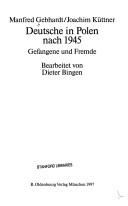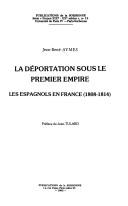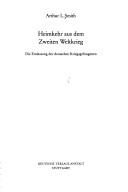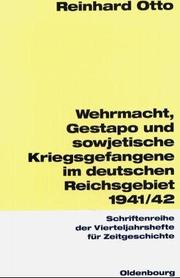| Listing 1 - 10 of 12 | << page >> |
Sort by
|
Book
Year: 2015 Publisher: Karlsruhe : KIT Scientific Publishing,
Abstract | Keywords | Export | Availability | Bookmark
 Loading...
Loading...Choose an application
- Reference Manager
- EndNote
- RefWorks (Direct export to RefWorks)
The titels alludes to the Dutch family history of Geert Mak "De eeuw van mijn vader" an exemplary history of Dutch society and mentalites. There are similarities to Walter Kempowskis historical narration "Deutsche Chronik" The double biographies of Rudi Kunze (1925 - 2001) and Gerda Kunze (1926 - 2010) are a unique, Hollywood-like movie plot and a characteristically German narration in the half century of extremes.
Book
ISBN: 348658328X 3486707523 Year: 2008 Publisher: De Gruyter
Abstract | Keywords | Export | Availability | Bookmark
 Loading...
Loading...Choose an application
- Reference Manager
- EndNote
- RefWorks (Direct export to RefWorks)
Eleven million German soldiers were captured during the Second World War, of which over three million were in British camps. For the first time, Renate Held presents the British prisoner of war policy comprehensively. It reveals motives, decision-making processes and acts of detention as well as their effects on the prisoners concerned. She embeds her everyday and mental history research object in the military and political history framework. It becomes clear how much the fate and everyday life of the prisoners depended on the course of the war and the political decisions of the opponents of the war.
Prisoners of war --- World War, 1939-1945 --- Prisoners and prisons, German. --- Exchange of prisoners of war --- POWs (Prisoners of war) --- War prisoners --- Prisoners

ISBN: 348670785X 3486562363 Year: 1997 Publisher: De Gruyter
Abstract | Keywords | Export | Availability | Bookmark
 Loading...
Loading...Choose an application
- Reference Manager
- EndNote
- RefWorks (Direct export to RefWorks)
Diese Edition dokumentiert zwei deutsche Schicksale in Polen, die unmittelbar mit dem Zusammenbruch der deutschen Herrschaft im Osten verbunden waren. Manfred Gebhardts Aufzeichnungen reflektieren Romantizismus, Naivität, vor allem aber Sensibilität eines jungen deutschen Soldaten, der in der Kriegsgefangenschaft erstmals direkt dem Land Polen und polnischen Menschen begegnet. Sie schildern die bisher wenig bekannte und dokumentierte Gefangenschaft deutscher Soldaten in Polen und die "Antifa"-Umerziehung, die eine erste "sozialistische Klassensolidarität" deutscher und polnischer Kommunisten begründen sollte. Die Aufzeichnungen dokumentieren ebenso ein Stück DDR-Gründungsgeschichte und sie sind zugleich be-eindruckendes Zeugnis der Suche nach Subjektivität und Objektivität eines Zeitzeugen, der später in der DDR eine nicht unwichtige Rolle im Pressewesen einnahm. Wie anders liest sich die Lebensgeschichte Joachim Küttners, der bis zu seiner abenteuerlichen Flucht in die Bundesrepublik 1958 immer mit Polen zusammengelebt hatte. Als deutscher Rittergutserbe wurde er im südlichen Teil des Posener Landes geboren, nahe der Grenze an der Prosna zum russischen Teilungsgebiet. Zwischenzeitlich wurde er polnischer Staatsbürger, seit 1939 im neu errichteten Reichsgau Wartheland aber wieder privilegiert und wie Millionen seiner Volksgenossen dazu ausersehen, zur "völkischen Neuordnung" in diesem Teil Polens beizutragen. Nach dem Zusammenbruch der nationalsozialistischen Herrschaft sollte sich das Bild auf dramatische Weise wenden. Mit dem Augenblick dieser Wende beginnt Küttners Bericht. Die Gefangennahme Manfred Gebhardts in Böhmen mündet in eine vierjährige Lagerhaft, die Flucht Joachim Küttners vor der herannahenden Front in ein dreizehn Jahre währendes pseudonymes Leben. Gebhardt und Küttner lebten in Polen als "Gefangene und Fremde". Ihre Erfahrungen sind beispielhaft für die durch die jüngste Vergangenheit schwer belastete Begegnung von Deutschen und Polen nach dem Ende des Zweiten Weltkrieges.
Prisoners of war --- Germans --- Gebhardt, Manfred. --- Küttner, Joachim, --- Poland --- History --- Ethnology
Book
Abstract | Keywords | Export | Availability | Bookmark
 Loading...
Loading...Choose an application
- Reference Manager
- EndNote
- RefWorks (Direct export to RefWorks)
Up to the 1980s prisoners of war were hardly even mentioned in military history. Only in recent years have scientists acknowledged the importance of this topic. For their investigations some of them chose the First World War, especially the Eastern front, where more than 5 million soldiers were captured until the revolutionary events of 1917/18. Contrary to the few existing studies, the present publication concentrates more on the evaluation of captivity in the historical background rather than on the description of "POW-fates" in "the hands of their enemies". It therefore focuses on the meaning of captivity and repatriation during the Russian Revolution and the establishment of the Communist International. Based on documents of the central archives in Vienna and Moscow, the thesis comes to the following results: On the one hand, conflicts between the soldiers of the Central Powers in the former Tsarist empire, in particular between the Austro-Hungarian nationalities, for example between the "Bolshevik internationalists" and the "Czech Legion", played a decisive role in the beginning of an Eastern European "period of confusion" which can hardly be entitled a "Russian Civil War". On the other hand, former prisoners functioned as founders of the Comintern and leaders of the first communist parties outside Soviet Russia. The activities of POWs thus marked the starting point of the international cadrerecruitment for the Comintern, which became a significant aspect in the foreign politics of the "first proletarian republic" and consequently in the so called "short 20th century" defined by the existence of the USSR and its "satellite states".
Communism --- Prisoners of war --- Socialism, Communism & Anarchism --- Political Science --- Law, Politics & Government --- History --- Exchange of prisoners of war --- POWs (Prisoners of war) --- War prisoners --- Prisoners --- Bolshevism --- Communist movements --- Leninism --- Maoism --- Marxism --- Trotskyism --- Collectivism --- Totalitarianism --- Post-communism --- Socialism --- Village communities --- First Wold War --- Eastern front --- prisoners --- Erster Weltkrieg --- Ostmitteleuropa --- Kommunismusforschung --- Kriegsgefangenenforschung --- Russland --- Ungarn

ISBN: 9791035105075 2859440615 Year: 2020 Publisher: Paris : Éditions de la Sorbonne,
Abstract | Keywords | Export | Availability | Bookmark
 Loading...
Loading...Choose an application
- Reference Manager
- EndNote
- RefWorks (Direct export to RefWorks)
Cet ouvrage étudie une population espagnole déportée, de plus de 50 000 personnes — prisonniers de guerre, marins, otages, suspects — dans ses comportements nationaux et catégoriels. Les opinions politiques s’y dévoilent, saisies à travers les évasions, la prestation ou le refus du serment de soumission au roi Joseph Bonaparte, les incorporations dans l’armée impériale, la correspondance interceptée que les déportés échangeaient entre eux. Le système de déportation fonctionne dans les faits, à l’échelon local, de manière plus chaotique qu’on ne l’aurait imaginé : depuis l’incarcération impitoyable des résistants illustres et des « exaltés » dans des forteresses jusqu’à la constitution de dizaines de « bataillons de travailleurs » chargés, ici et là, de creuser des canaux, d’assécher des marécages et de construire des routes. Émanant de diverses classes de la population et régions de France, les documents d’archives témoignent enfin de la façon dont les sujets de l’Empereur, loin d’imiter leur souverain crispé dans ses préjugés et sa rancœur anti-ibériques, réagissent plutôt favorablement devant cette masse, d’étrangers qui, cessant d’être à leurs yeux des ennemis détestables, sont souvent considérés comme des alliés malheureux, en vertu d’affinités politiques et religieuses dont la ferveur irrite les partisans de Napoléon.
Peninsular War, 1807-1814 --- Prisoners of war --- Spaniards --- Prisoners and prisons, French. --- Prisoners and prisons, French --- Sources. --- History --- Spanish people --- Ethnology --- Napoleonic Wars, 1800-1815 --- Exchange of prisoners of war --- POWs (Prisoners of war) --- War prisoners --- Prisoners --- prison --- Espagne --- prisonniers --- déportation --- guerre d’Espagne
Book
ISBN: 9791035105037 Year: 2020 Publisher: Paris : Éditions de la Sorbonne,
Abstract | Keywords | Export | Availability | Bookmark
 Loading...
Loading...Choose an application
- Reference Manager
- EndNote
- RefWorks (Direct export to RefWorks)
Un million de P.G. libérés rentrent au printemps 1945 dans leur foyer. La société française récupère brusquement une masse d’hommes dans la force de l’âge, de producteurs, de procréateurs, d’électeurs, de cadres. Bien peu d’attention fut consacrée alors à cet imposant phénomène de réinsertion sociale occulté depuis par l’historiographie contemporaine. Pourtant, ces retrouvailles difficiles entre un pays bouleversé et un groupe d’hommes ne ressemblant guère à ceux qui quittèrent six ans plus tôt leur foyer étaient génératrices de changements. Leur étude permet aussi de comparer la mentalité, les modes d’action et les comportements d’une génération d’Anciens Combattants à celle de leurs pères.
World War, 1939-1945 --- Prisoners of war --- Prisoners and prisons, German. --- History --- Societies, etc. --- Fédération nationale des prisonniers de guerre. --- Exchange of prisoners of war --- POWs (Prisoners of war) --- War prisoners --- Prisoners --- F.N.P.G. --- FNPG --- prisonniers --- Fédération nationale des prisonniers de guerre --- Fédération nationale des combattants prisonniers de guerre et combattants d’Algérie --- prisonnier de guerre --- Seconde Guerre mondiale

ISBN: 3421062951 3486703293 Year: 1985 Publisher: Stuttgart Deutsche Verlags-Anstalt
Abstract | Keywords | Export | Availability | Bookmark
 Loading...
Loading...Choose an application
- Reference Manager
- EndNote
- RefWorks (Direct export to RefWorks)
Über das Los der deutschen Soldaten, die während und am Ende des Zweiten Weltkriegs in Gefangenschaft gerieten, ist oft berichtet worden; weitgehend unerforscht aber blieb das zeitgeschichtliche Folgekapitel: die Rückkehr. Der amerikanische Historiker Arthur L. Smith hat es als erster unternommen, die Geschichte der Heimkehr der deutschen Gefangenen und ihrer Reintegration ins Zivilleben darzustellen. Ungewöhnlich viel Zeit und Aufwand musste in die Sammlung der besonders weit verstreuten Quellen investiert werden; denn in den Jahren 1945 bis 1949 existierte keine zentrale Stelle in Deutschland, die für diese besondere Demobilmachung zuständig gewesen wäre. Smith schildert eine eindrucksvolle Fülle von Versuchen, den Heimkehrern in ihren Nöten beizustehen, unternommen von Politikern, Geistlichen und engagierten Privatleuten - doch wird zugleich deutlich, dass die Anstrengungen selten erfolglos waren. Die desillusionierten Soldaten kehrten ja in ein Land zurück, dessen Städte in Trümmern lagen und das - in vier Besatzungszonen geteilt - seine staatliche Einheit verloren hatte. Aber selbst eine Nation, die zwischen dem Schock der Niederlage und dem Gefühl der Befreiung von Krieg und NS-Herrschaft noch keine rechte Orientierung fand, war sich bewusst, dass die Eingliederung der entlassenen Kriegsgefangenen zu ihren wichtigsten Aufgaben gehörte: Bis 1949, als die Bundesrepublik entstand, war schon eine feste Basis für umfassende Unterstützungsprogramme geschaffen.
Prisoners of war --- -World War, 1939-1945 --- -European War, 1939-1945 --- Second World War, 1939-1945 --- World War 2, 1939-1945 --- World War II, 1939-1945 --- World War Two, 1939-1945 --- WW II (World War, 1939-1945) --- WWII (World War, 1939-1945) --- History, Modern --- Exchange of prisoners of war --- POWs (Prisoners of war) --- War prisoners --- Prisoners --- History --- -Prisoners and prisons --- Reparations --- Social aspects --- -Germany --- Politics and government --- -Prisoners of war --- -History --- World War, 1939-1945 --- Prisoners and prisons. --- Reparations. --- Germany --- European War, 1939-1945 --- Reconstruction (1939-1951) --- Economic aspects --- Prisoners and prisons

ISBN: 3486645773 3486702998 Year: 1998 Publisher: München Oldenbourg
Abstract | Keywords | Export | Availability | Bookmark
 Loading...
Loading...Choose an application
- Reference Manager
- EndNote
- RefWorks (Direct export to RefWorks)
Im Juli 1941 erließ das Reichssicherheitshauptamt in enger Abstimmung mit dem Oberkommando der Wehrmacht die Einsatzbefehle Nr. 8 und Nr.9. Sowjetische Kriegsgefangene, die nach ideologischen Kriterien als "untragbar" eingestuft wurden - weil sie Juden, Kommunisten oder Angehörige der sowjetischen Intelligenz waren - sollten demnach aus den Kriegsgefangenenlagern im Reich und im Generalgouvernement ausgesondert und im jeweils nächstgelegenen Konzentrationslager getötet werden. Einsatzkommandos der Gestapo nahmen die Aussonderung vor und kooperierten dabei mit den entsprechenden Instanzen der Wehrmacht. Obwohl der Bruch des Kriegsvölkerrechts offenkundig war, kam es von Seiten des Militärs nur vereinzelt zu Widerständen gegen das Mordprogramm, dem bis Sommer 1942 mindestens 38.000 Soldaten der Roten Armee zum Opfer fielen. Auf breiter Quellenbasis, darunter erst jetzt zugängliche Dokumente aus russischen Archiven, analysiert Reinhard Otto minutiös ein von Wissenschaft und Öffentlichkeit lange Zeit ignoriertes Großverbrechen des NS-Regimes und seinen engen Zusammenhang mit dem Arbeitseinsatz der sowjetischen Kriegsgefangenen.
Genocide --- -Genocide --- -Prisoners of war --- -World War, 1939-1945 --- -European War, 1939-1945 --- Second World War, 1939-1945 --- World War 2, 1939-1945 --- World War II, 1939-1945 --- World War Two, 1939-1945 --- WW II (World War, 1939-1945) --- WWII (World War, 1939-1945) --- History, Modern --- Exchange of prisoners of war --- POWs (Prisoners of war) --- War prisoners --- Prisoners --- Cleansing, Ethnic --- Ethnic cleansing --- Ethnic purification --- Ethnocide --- Purification, Ethnic --- Crime --- History --- -History --- Atrocities --- Prisoners and prisons, German --- Germany. Geheime Staatspolizei --- Germany --- Armed Forces. --- World War, 1939-1945 --- Prisoners of war --- Prisoners and prisons, German. --- History. --- Atrocities. --- Germany. --- Gestapo
Book
ISBN: 047290390X 0472056492 0472076493 Year: 2023 Publisher: Ann Arbor, Michigan : University of Michigan Press,
Abstract | Keywords | Export | Availability | Bookmark
 Loading...
Loading...Choose an application
- Reference Manager
- EndNote
- RefWorks (Direct export to RefWorks)
The American presidency has long tested the capacity of the system of checks and balances to constrain executive power, especially in times of war. While scholars have examined presidents starting military conflicts without congressional authorization or infringing on civil liberties in the name of national security, Stuart Streichler focuses on the conduct of hostilities. Using the treatment of war-on-terror detainees under President George W. Bush as a case study, he integrates international humanitarian law into a constitutional analysis of the repercussions of presidential war powers for human rights around the world. Putting President Bush's actions in a wider context, Presidential Accountability in Wartime begins with a historical survey of the laws of war, with particular emphasis on the 1949 Geneva Conventions and the Nuremberg Tribunal. Streichler then reconstructs the decision-making process that led to the president's approval of interrogation methods that violated Geneva's mandate to treat wartime captives humanely. While taking note of various accountability options-from within the executive branch to the International Criminal Court-the book illustrates the challenge in holding presidents personally responsible for violating the laws of war through an in-depth analysis of the actions taken by Congress, the Supreme Court, and the public in response. In doing so, this book not only raises questions about whether international humanitarian law can moderate wartime presidential behavior but also about the character of the presidency and the American constitutional system of government.
Executive power --- History. --- Bush, George W. --- War on Terrorism, 2001-2009. --- Prisoners of war --- War crimes (International law) --- Abuse of --- History
Book
ISBN: 0814790798 0814773435 9780814773437 9780814790793 9780814737033 081473703X Year: 2010 Publisher: New York : New York University Press,
Abstract | Keywords | Export | Availability | Bookmark
 Loading...
Loading...Choose an application
- Reference Manager
- EndNote
- RefWorks (Direct export to RefWorks)
The U.S. detention center at Guantánamo Bay has long been synonymous with torture, secrecy, and the abuse of executive power. It has come to epitomize lawlessness and has sparked protracted legal battles and political debate. For too long, however, Guantánamo has been viewed in isolation and has overshadowed a larger, interconnected global detention system that includes other military prisons such as Bagram Air Base in Afghanistan, secret CIA jails, and the transfer of prisoners to other countries for torture. Guantánamo is simply—and alarmingly—the most visible example of a much larger prison system designed to operate outside the law.Habeas Corpus after 9/11 examines the rise of the U.S.-run global detention system that emerged after 9/11 and the efforts to challenge it through habeas corpus (a petition to appear in court to claim unlawful imprisonment). Habeas expert and litigator Jonathan Hafetz gives us an insider’s view of the detention of “enemy combatants” and an accessible explanation of the complex forces that keep these systems running. In the age of terrorism, some argue that habeas corpus is impractical and unwise. Hafetz advocates that it remains the single most important check against arbitrary and unlawful detention, torture, and the abuse of executive power.
Prisoners of war --- Detention of persons --- Combatants and noncombatants (International law) --- Terrorism --- Habeas corpus --- Exchange of prisoners of war --- POWs (Prisoners of war) --- War prisoners --- Prisoners --- Noncombatants (International law) --- Armed Forces --- Belligerency --- Military law --- International law --- Legal status, laws, etc. --- Prevention. --- Guantánamo Bay Detention Camp. --- Guantánamo (Detention camp : Guantánamo Bay Naval Base) --- Gitmo (Detention camp : Guantánamo Bay Naval Base) --- Guantánamo Bay Naval Base (Cuba). --- Camp Delta (Guantánamo Bay Naval Base) --- 911. --- US-run. --- after. --- appear. --- challenge. --- claim. --- corpus. --- court. --- detention. --- efforts. --- emerged. --- examines. --- global. --- habeas. --- imprisonment. --- petition. --- rise. --- system. --- that. --- through. --- unlawful. --- United States --- Prevention --- Cuba --- Guantánamo Bay Naval Base (Cuba) --- Guantánamo Bay Detention Camp --- Guantanamo Bay Detention Camp.
| Listing 1 - 10 of 12 | << page >> |
Sort by
|

 Search
Search Feedback
Feedback About UniCat
About UniCat  Help
Help News
News